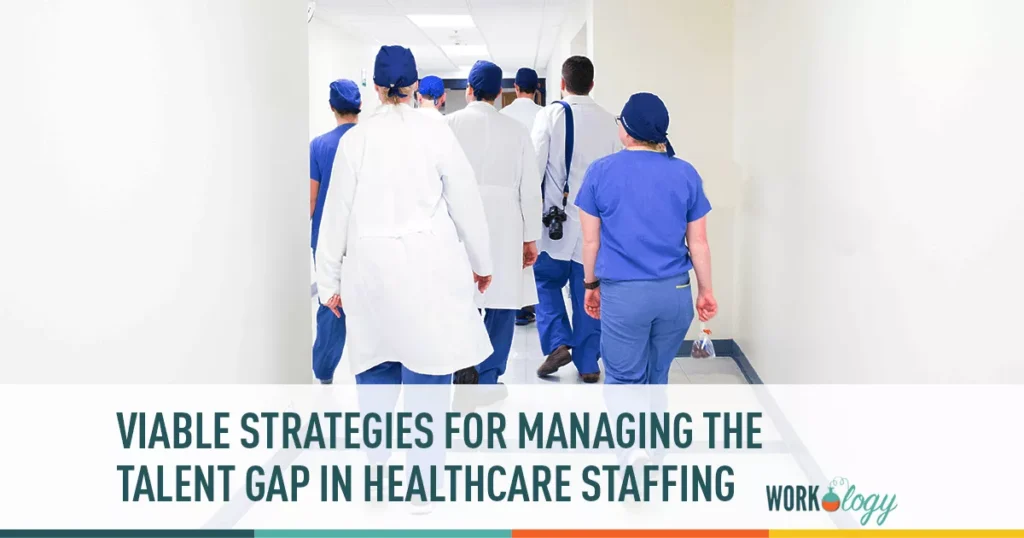Globally, talent shortages top the list of the most compelling risks that all business organizations are facing. This is particularly true in the healthcare industry, where shortages of doctors, nurses, and other healthcare professionals are affecting a sizable percentage of the world’s population.
Viable Strategies for Managing the Talent Gap in Healthcare Staffing
There are multiple reasons for these talent shortages. For starters, government regulations dictate many of the criteria necessary for getting hired as a clinician. After completing their medical education, Doctors of Medicine must pass all three parts of the United States Medical Licensing Examination (USMLE), and Doctors of Osteopathic Medicine must pass all three levels of the Comprehensive Osteopathic Medical Licensing Examination (COMLEX-USA). It isn’t an option for healthcare organizations to hire doctors, nurses, or specialists who fall short of predefined standards. Cutting corners is taboo, and this makes it notoriously hard to find qualified candidates.
Furthermore, there’s a bottleneck in the numbers of nurses, doctors, and other healthcare professionals that can get trained at any given time. There are limits on the numbers of applicants that the medical schools and nursing schools can accept.
Then, once the newly-trained clinicians are on the job, the burnout levels among these professionals are high. Many people who train for healthcare careers do not remain in the industry for the long term.
In particular, there is high turnover among female clinicians; the Association of American Medical Colleges (AAMC) reports that 40 per cent of female physicians stop working in the industry or transition to part-time work within 6 years of having finished their residencies. Many of the qualified healthcare professionals who are currently engaged in the workforce are nearing retirement age, which means the talent shortage is likely to get even worse in the future.
Adding to the complexity of the problem is the growing demand for healthcare. Between the COVID-19 crisis and the aging population, demand for healthcare services has been skyrocketing.
These are problems that do not have quick or simple solutions. Many healthcare administrators and human resources managers across the globe are facing similar challenges in trying to staff their organizations. However, there are a few strategies that hiring managers can utilize to attract and retain qualified talent at their facilities.
Make Employee Retention a Top Priority
When there’s a lack of talented people to start with, employee retention has to be one of the organization’s most critically urgent priorities.
Employee retention has multiple facets:
– Allowing for work-life balance
– Ensuring employees are recognized and rewarded for their contributions to the organization
– Taking employees’ concerns seriously
A lack of work-life balance is one of the most frequent reasons that clinicians leave the healthcare industry. This is particularly true for female doctors and nurses. Many of them have children and assume parental duties in addition to their professional duties. Initiating on-site childcare services and allowing for paid parental leave can make a huge difference in retaining these employees rather than losing them to burnout.
Use a Talent Gap Analysis
As a hiring manager, you probably don’t have a crystal ball you can use for peering into the future to see what phenomenon will affect your organization in the months and years ahead. A talent gap analysis isn’t exactly a crystal ball, but it can serve a similar function of sorts. It’s a tool that can help you predict what your future talent needs are likely to look like. It can also help you get a better understanding of what steps, exactly, you will need to take to meet your future staffing needs. A talent gap analysis is intended to help hiring managers to fill in the gaps in your current staff to build the workforce you’ll need for meeting the future demands of your healthcare organization.
For example, conducting a talent gap analysis could help you to identify that your organization is likely to need to either hire or train new nurse practitioners within the next several years. If your group already employs motivated RNs, some of them could be incentivized to earn a Master of Advanced Nursing degree, which could help to qualify them for promotion into the newly available nurse practitioner roles. Having the option to promote from within would be an advantage over having to recruit qualified nurse practitioners, who are currently in short supply and high demand.
The talent shortage in healthcare won’t be going away any time soon. However, these strategies can help you better attract and retain talent to minimize any impact that your organization will experience as a result of the talent shortage.








